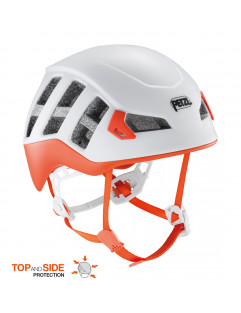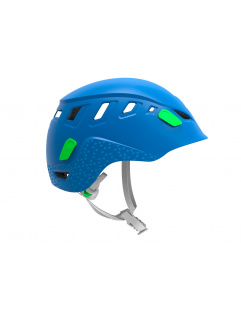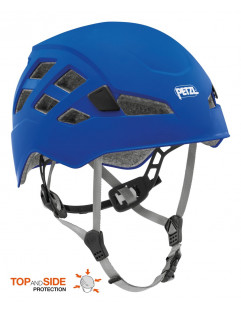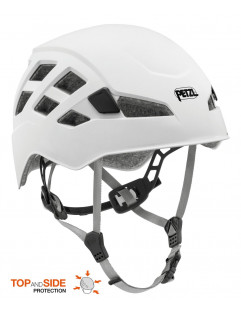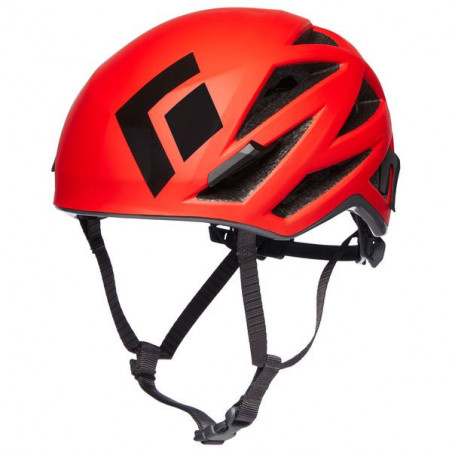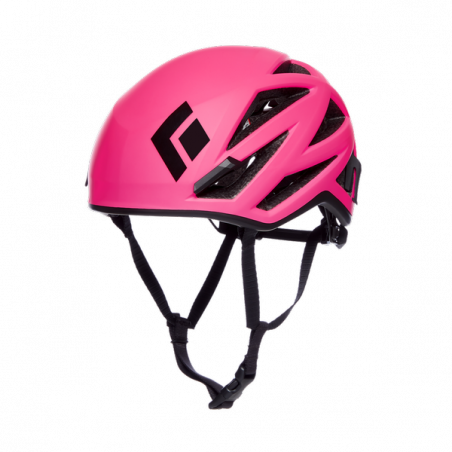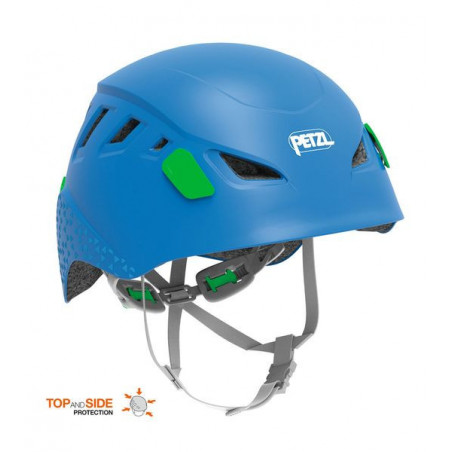Active filters
hybrid-helmets
Petzl - Meteor - Climbing Helmetkids-helmets
Petzl - Picchu - Blue - Kid's Climbing Helmetmens-helmets
Petzl - Boreo - Blue - Climbing Helmethome
Petzl - Boreo - White - Climbing Helmetactivities
Petzl - Boreo - Gray - Climbing Helmetactivities
Petzl - Boreo - Orange - Climbing Helmet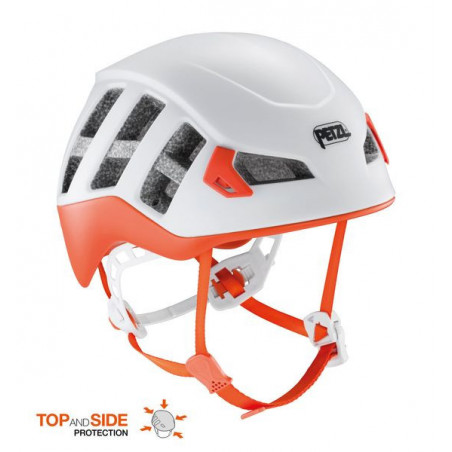
Helmets
How to Choose A Climbing Helmet?
Wearing a climbing helmet is an important part of keeping yourself protected at the crag, wether your climbing or belaying. A helmet will protect you from rocks falling down on you, you falling down and hitting the rock or banging your head in the overhang. When getting a helmet there are three main things to consider, helmet type, type of climbing you do and getting the right fit.
All helmets must meet industry standards for impact protection, with the standard for overhead protection being greater than the side-protection standard.
Climbing Helmet Type
Hardshell Helmets are durable and have an extra hard outer shell usually made of ABS plastic giving them a long lifespan compared to other helmets. They feature a thin foam layer inside and a strap suspension system and are therefor sometimes called hybrid helmets or suspension helmets.
Shelled Foam Helmets are lighter and feature a thick layer of impact-absorbing polystyrene or polypropylene foam protected by a thin polycarbonate shell. This type of helmet has the advantage of being super light and having great ventilation.
| hardshell helmet | shelled foam helmet | |
| Mountaineering and multi-pitch trad climbing | X | |
| Ice climbing | X | |
| Warm-weather sport climbing | X | |
| Cool-weather and single-pitch sport climbing | X | X |
| Belaying | X | |
| Indoor climbing | X | X |
Climbing Helmet Fit
Even when friends or reviewers suggest that one helmet is the best, it won't be right for you if it doesn't fit correctly. The best way to assess fit is to try on different helmets in a climbing specialty store.
- Check for a secure fit
- Check and adjust chin straps
- Check the ease of adjustment
Climbing Helmet Lifespan
You should retire any helmet that’s dented, cracked or damaged—that includes the straps. You should even retire your helmet if you can't see any damage but had an incident where you thought to yourself, "I would have been seriously messed up if not for my helmet."
Even if it’s never impacted, retire a helmet within 10 years. The sun’s UV rays slowly degrade materials, so if you climb frequently, cut this lifespan time in half.
The choices are endless and difficult today so contact our Customer Service or send us a mail to help you choose the right product for your needs.
Shop online.........more time to climb.
Casper's Supports Your Summit
Subcategories
-
Mens Helmets
<h1><strong><span>How to Choose A Climbing Helmet?</span></strong></h1> <p>Wearing a climbing helmet is an important part of keeping yourself protected at the crag, wether your climbing or belaying. A helmet will protect you from rocks falling down on you, you falling down and hitting the rock or banging your head in the overhang. When getting a helmet there are three main things to consider, helmet type, type of climbing you do and getting the right fit. </p> <p>All helmets must meet industry standards for impact protection, with the standard for overhead protection being greater than the side-protection standard.</p> <h2><span>Climbing Helmet Type</span></h2> <p><b>Hardshell Helmets </b>are durable and have an extra hard outer shell usually made of ABS plastic giving them a long lifespan compared to other helmets. They feature a thin foam layer inside and a strap suspension system and are therefor sometimes called hybrid helmets or suspension helmets.</p> <p><b>Shelled Foam Helmets </b>are lighter and feature a thick layer of impact-absorbing polystyrene or polypropylene foam protected by a thin polycarbonate shell. This type of helmet has the advantage of being super light and having great ventilation. </p> <table width="409"> <tbody> <tr> <td></td> <td>hardshell helmet</td> <td>shelled foam helmet</td> </tr> <tr> <td>Mountaineering and multi-pitch trad climbing</td> <td></td> <td>X</td> </tr> <tr> <td>Ice climbing</td> <td></td> <td>X</td> </tr> <tr> <td>Warm-weather sport climbing</td> <td></td> <td>X</td> </tr> <tr> <td>Cool-weather and single-pitch sport climbing</td> <td>X</td> <td>X</td> </tr> <tr> <td>Belaying</td> <td>X</td> <td></td> </tr> <tr> <td>Indoor climbing</td> <td>X</td> <td>X</td> </tr> </tbody> </table> <p></p> <h2><span><b>Climbing</b> <b>Helmet Fit</b></span></h2> <p>Even when friends or reviewers suggest that one helmet is the best, it won't be right for you if it doesn't fit correctly. The best way to assess fit is to try on different helmets in a climbing specialty store.</p> <ul> <li>Check for a secure fit</li> <li>Check and adjust chin straps</li> <li>Check the ease of adjustment</li> </ul> <h2><span><b>Climbing Helmet Lifespan</b></span></h2> <p>You should retire any helmet that’s dented, cracked or damaged—that includes the straps. You should even retire your helmet if you can't see any damage but had an incident where you thought to yourself, "I would have been seriously messed up if not for my helmet."</p> <p>Even if it’s never impacted, retire a helmet within 10 years. The sun’s UV rays slowly degrade materials, so if you climb frequently, cut this lifespan time in half.</p> <p></p> <p>The choices are endless and difficult today so contact our <a href="/contact-us">Customer Service</a> or <a href="mailto:info@caspersclimbingshop.com">send us a mail</a> to help you choose the right product for your needs. </p> <p></p> <p>Shop online.........more time to climb.</p> <p></p> <p>Casper's Supports Your Summit</p> -
Women Helmets
<h1><strong><span>How to Choose A Climbing Helmet?</span></strong></h1> <p>Wearing a climbing helmet is an important part of keeping yourself protected at the crag, wether your climbing or belaying. A helmet will protect you from rocks falling down on you, you falling down and hitting the rock or banging your head in the overhang. When getting a helmet there are three main things to consider, helmet type, type of climbing you do and getting the right fit. </p> <p>All helmets must meet industry standards for impact protection, with the standard for overhead protection being greater than the side-protection standard.</p> <h2><span>Climbing Helmet Type</span></h2> <p><b>Hardshell Helmets </b>are durable and have an extra hard outer shell usually made of ABS plastic giving them a long lifespan compared to other helmets. They feature a thin foam layer inside and a strap suspension system and are therefor sometimes called hybrid helmets or suspension helmets.</p> <p><b>Shelled Foam Helmets </b>are lighter and feature a thick layer of impact-absorbing polystyrene or polypropylene foam protected by a thin polycarbonate shell. This type of helmet has the advantage of being super light and having great ventilation. </p> <table width="409"> <tbody> <tr> <td></td> <td>hardshell helmet</td> <td>shelled foam helmet</td> </tr> <tr> <td>Mountaineering and multi-pitch trad climbing</td> <td></td> <td>X</td> </tr> <tr> <td>Ice climbing</td> <td></td> <td>X</td> </tr> <tr> <td>Warm-weather sport climbing</td> <td></td> <td>X</td> </tr> <tr> <td>Cool-weather and single-pitch sport climbing</td> <td>X</td> <td>X</td> </tr> <tr> <td>Belaying</td> <td>X</td> <td></td> </tr> <tr> <td>Indoor climbing</td> <td>X</td> <td>X</td> </tr> </tbody> </table> <p></p> <h2><span><b>Climbing</b> <b>Helmet Fit</b></span></h2> <p>Even when friends or reviewers suggest that one helmet is the best, it won't be right for you if it doesn't fit correctly. The best way to assess fit is to try on different helmets in a climbing specialty store.</p> <ul> <li>Check for a secure fit</li> <li>Check and adjust chin straps</li> <li>Check the ease of adjustment</li> </ul> <h2><span><b>Climbing Helmet Lifespan</b></span></h2> <p>You should retire any helmet that’s dented, cracked or damaged—that includes the straps. You should even retire your helmet if you can't see any damage but had an incident where you thought to yourself, "I would have been seriously messed up if not for my helmet."</p> <p>Even if it’s never impacted, retire a helmet within 10 years. The sun’s UV rays slowly degrade materials, so if you climb frequently, cut this lifespan time in half.</p> <h3><strong>Specific Women Helmet</strong></h3> <p>There are specific helmets designed for women since the size of a woman's head varies to men. In general the headsize is a bit smaller but depending on the hair style it can be quiet big. Nothing about the helmet changes, except for some brands like Petzl with their Borea model, that has a special shape in order to comfortably fir a pony tail hair style at the back.</p> <p><img src="https://caspersclimbingshop.com/img/cms/A048-BOREA-focus-1_LowRes.jpeg" alt="" width="400" height="287" /></p> <p><a href="https://www.caspersclimbingshop.com/search?controller=search&orderby=position&orderway=desc&search_query=borea&submit_search=" target="_blank" class="btn btn-default" rel="noreferrer noopener">Petzl Borea Helmet</a></p> <h3></h3> <p>The choices are endless and difficult today so contact our <a href="/contact-us">Customer Service</a> or <a href="mailto:info@caspersclimbingshop.com">send us a mail</a> to help you choose the right product for your needs. </p> <p></p> <p>Shop online.........more time to climb.</p> <p></p> <p>Casper's Supports Your Summit</p> -
Kids Helmets
<h2>Climbing Helmet Type</h2> <p><b>Hardshell Helmets </b>are durable and have an extra hard outer shell usually made of ABS plastic giving them a long lifespan compared to other helmets. They feature a thin foam layer inside and a strap suspension system and are therefor sometimes called hybrid helmets or suspension helmets.</p> <p><b>Shelled Foam Helmets </b>are lighter and feature a thick layer of impact-absorbing polystyrene or polypropylene foam protected by a thin polycarbonate shell. This type of helmet has the advantage of being super light and having great ventilation. </p> <table width="409"> <tbody> <tr> <td></td> <td>hardshell helmet</td> <td>shelled foam helmet</td> </tr> <tr> <td>Mountaineering and multi-pitch trad climbing</td> <td></td> <td>X</td> </tr> <tr> <td>Ice climbing</td> <td></td> <td>X</td> </tr> <tr> <td>Warm-weather sport climbing</td> <td></td> <td>X</td> </tr> <tr> <td>Cool-weather and single-pitch sport climbing</td> <td>X</td> <td>X</td> </tr> <tr> <td>Belaying</td> <td>X</td> <td></td> </tr> <tr> <td>Indoor climbing</td> <td>X</td> <td>X</td> </tr> </tbody> </table> <p></p> <h2><span><b>Climbing</b> <b>Helmet Fit</b></span></h2> <p>Even when friends or reviewers suggest that one helmet is the best, it won't be right for you if it doesn't fit correctly. The best way to assess fit is to try on different helmets in a climbing specialty store.</p> <ul> <li>Check for a secure fit</li> <li>Check and adjust chin straps</li> <li>Check the ease of adjustment</li> </ul> <h2><span><b>Climbing Helmet Lifespan</b></span></h2> <p>You should retire any helmet that’s dented, cracked or damaged—that includes the straps. You should even retire your helmet if you can't see any damage but had an incident where you thought to yourself, "I would have been seriously messed up if not for my helmet."</p> <p>Even if it’s never impacted, retire a helmet within 10 years. The sun’s UV rays slowly degrade materials, so if you climb frequently, cut this lifespan time in half.</p> <h2><strong>Kids specific</strong></h2> <p>There is nothing really kid specific about these helmets except for the adjusted size. These helmets or obviously not as big as adult helmets but except for that they are identical. </p> <p><img src="https://caspersclimbingshop.com/img/cms/picchu2017.jpeg" alt="" width="400" height="400" /></p> <p><a href="https://www.caspersclimbingshop.com/kids-helmets/2062-picchu2017.html" target="_blank" class="btn btn-default" rel="noreferrer noopener">Petzl Picchu Kids Helmet</a></p> <p></p> <p>The choices are endless and difficult today so contact our <a href="/contact-us">Customer Service</a> or <a href="mailto:info@caspersclimbingshop.com">send us a mail</a> to help you choose the right product for your needs. </p> <p></p> <p>Shop online.........more time to climb.</p> <p></p> <p>Casper's Supports Your Summit</p>









